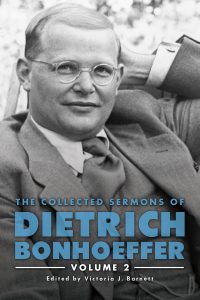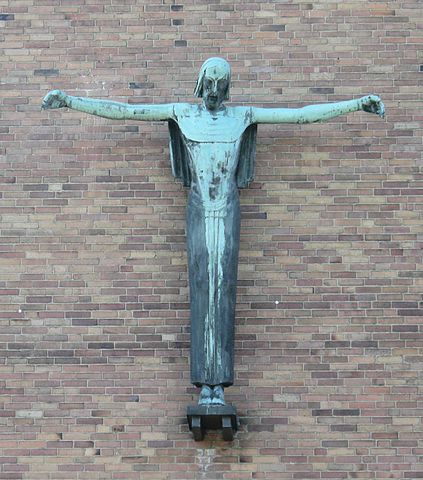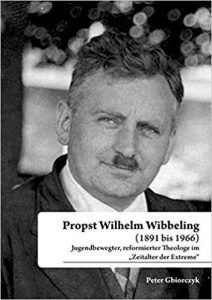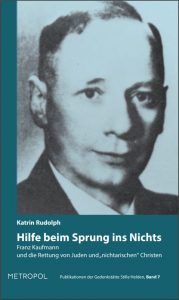Contemporary Church History Quarterly
Volume 24, Number 3 (September 2018)
Review of Victoria J. Barnett, ed., The Collected Sermons of Dietrich Bonhoeffer, Volume 2 (Minneapolis: Fortress Press, 2017). Pp. xvi + 253. ISBN: 978-1-5064-3336-3.
By Kyle Jantzen, Ambrose University
Victoria Barnett, general editor of the Dietrich Bonhoeffer Works, English edition, has ably selected, edited, and introduced 28 Bonhoeffer messages in this the second volume of his collected sermons. Bonhoeffer’s martyrdom has made him famous as a theologian and member of the German Resistance, but as Barnett points out, he was educated for careers in both academia and ministry. Indeed, one of the consistent features of Bonhoeffer’s “fragmentary life” was the writing and preaching of sermons (xi-xii). This collection of sermons and meditations, written between 1926 and 1944, certainly touch on many of the theological themes for which he is known in works like Discipleship, Life Together, Ethics, and Letters and Papers from Prison. More importantly, however, they demonstrate Bonhoeffer’s warm pastoral heart and deep personal piety. As Barnett observes, Bonhoeffer followed the lectionary, convinced that “Scripture, preached correctly, revealed the word of God to the listener” (xiii). At the same time, he believed that preaching should speak to the contemporary world. What is perhaps most interesting, though, is the way that these sermons open up a window into Bonhoeffer’s own inner life.
 Three themes run through these sermons: the seriousness of Bonhoeffer’s Christianity, the insight of his responses to the social and political crises of the late Weimar and Nazi eras, and the resolution of his engagement in the Kirchenkampf (German Church Struggle).
Three themes run through these sermons: the seriousness of Bonhoeffer’s Christianity, the insight of his responses to the social and political crises of the late Weimar and Nazi eras, and the resolution of his engagement in the Kirchenkampf (German Church Struggle).
From the beginning of his preaching career, Bonhoeffer proclaimed an uncompromising brand of Christianity. In “A Sermon for His Contemporaries” (1926), he describes God as “absolute holiness and absolute duty,” and declares that “God’s word always commands the fulfilling of this absolute duty” (5). Indeed, God’s authority overshadowed all others: “When we do not recognize all earthly authorities as being dependent on that one authority, we make them our idols, be they state, church, reason, or genius” (6). Paradoxically, it is in obedience to God that the Christian finds freedom: “when you are bound to God in obedience, then you have become truly free. You are free from everything from which you should be free; free from people and powers, because you are bound to God” (8).
The authority of Christ is echoed in “Seeing the World through the Eyes of Christ” (1927/8), in which Bonhoeffer pronounces:
Jesus Christ is looking for lodging. He is looking for entrance into our spirits and our hearts. Do we really understand what this means? Jesus Christ is a controlling, willful guest. He wants our hearts completely. He will not tolerate competition, even if the competition only wants to dispute Jesus’s right to the least bit of his possession. Jesus Christ is a discomforting, imperious guest. He will rule whoever invites him in, and whoever invites Jesus in must serve him. (19-20)
Typical of the “both-and” way of Bonhoeffer’s thinking, however, he goes on to proclaim that Jesus comes not to destroy but to comfort, promising to give sight and to bring love into the life of the Christian. In the end, all these ideas come together: “The act of Christian love is to manifest Jesus not as a religious genius, an ethical thinker, or a philosopher, but as the Lord of death and of life; as the Word of God made flesh, for whom command and promise are the same” (22).
Dependence on God’s grace emerges time and again in Bonhoeffer’s preaching. In “The Human Yearning for God,” he asserts that the way to God is through purity of heart, even though it is impossible to attain:
The most distressing realization in the life of every Christian is that we cannot remain pure, that day by day we fall down anew and night by night must cry out to God anew: Lord, I cannot do it alone; if you make me pure, then I am pure. May God create in me a pure heart. I want so much to be pure. I want so much to behold God. (46)
Bonhoeffer’s piety manifests itself once more in “Approaching the Day in Faith: Morning Devotions” (1935), written as a reflection on his experience with his Finkenwalde seminary students. “Each new morning,” he begins, “is a new beginning for our lives. … It is long enough to find or to lose God, to keep faith or to fall into sin and disgrace” (154). Each day is created by God. Each day is an opportunity to find new mercy. In each day, we require our daily bread. Bonhoeffer goes on to describe the practice of the Finkenwalde community—their habit of beginning each day with private and communal devotions. As Bonhoeffer put it, “One hour must be put aside each morning for quiet prayer and worship together. Truly, this is not wasted time. How else are we to face the tasks, tribulations, and temptations of the day?” (155).
The seriousness of Bonhoeffer’s Christianity is matched by the thoughtfulness of his responses to the rapid social change and political turbulence of his day. In this, his preaching is a model of pastoral care in times of trial. For example, “The Soul’s Silence before God” (1928) asks hard questions which speak not only to Bonhoeffer’s day but to ours:
Is there still something like the soul in an age such as ours, an age of machines, of economic competition, of the dominance of fashion and sports; is this nothing more than a cherished childhood memory, like so much else? It just sounds so strange and peculiar amid the confusion and loud voices extolling themselves, this little word “soul.” It speaks such a gentle, quiet language that we hardly hear it anymore amid the tumult and chaos inside us. Yet it speaks a language full of the greatest responsibility and of profound seriousness: you, human being, have a soul; beware, lest you lose it, lest you awaken one day amid the frenzy of life—in both work and private life—and find that inwardly you have become empty, a plaything of events, a leaf before the wind, driven to and fro and blown away—that you have lost your soul. (33)
His answer is to cultivate silence: “My soul becomes silent before God, who helps me. God’s hours are hours of succor and comfort. God has an answer for every distress of our soul, and this answer is always one and the same … the enticing words: I love you” (35-36).
Other sermons illustrate Bonhoeffer’s ability to take the long view in the midst of upheaval. In “At the Turning Point: Waiting for God” (1931), he references the instability and chaos of the late Weimar era. In an age of clashing world views, the popular expectation is that the human being should “hold his own,” “remain master of the world, master of the future” (61). Bonhoeffer notes the way in which the Bible sets out a different response to the future—a posture of waiting on God. The sermon closes with a prayer: “God, come into our waiting. God, we are waiting for your salvation, your judgment, for your love and your peace” (66). Similarly, in “Following Christ through the World to the Cross” (1932), Bonhoeffer explains how Christ rejected the temptation to be king of the world, forsaking worldly power in obedience to God. Christ’s path was the path of love for humans, the path of the cross. “And we walk with him, as individuals and also as the church. We are the church under the cross … our kingdom is not of this world” (70). Perhaps the most powerful sermon in this vein is “Staying Grounded in Turbulent Times” (1932). In the midst of (again) instability and competing world views, Bonhoeffer takes up the prayer of 2 Chronicles 20:12: “We do not know what to do, but our eyes are on you” (74). As is so often the case, Bonhoeffer’s preaching points to the mercy of God expressed in Christ’s saving death on the cross.
One of the surprising elements of these sermons is Bonhoeffer’s ability to find hope in the midst of trial. For instance, in a Christmas meditation written in 1940, Bonhoeffer explores the jubilant prophecy in Isaiah 9, detailing the wisdom, power, authority, love, and justice of Jesus and his kingdom. Concluding with the words of Isaiah: “The zeal of the Lord of hosts will do this,” Bonhoeffer proclaims:
The holy zeal of God for this divine kingdom guarantees that this kingdom will remain for eternity and will reach its final fulfillment despite all human guilt, all resistance. It will not depend on whether we participate. God brings his plans to fruition with or despite us. But God desires for us to be with him. Not for God’s own sake but for our sake. God with us—Immanuel—Jesus—that is the mystery of this Holy Night. But we cry out with joy: “For a child has been born for us, a son given to us.” I believe that Jesus Christ—a true human being, born of the Virgin Mary, and true God, begotten of the Father in eternity—is my Lord. (208)
A few of the sermons in this volume reference more directly the state and church politics of the late 1920s and early 1930s. The most forceful of these is “… In the Eleventh Hour of Our Church” (1932), which Bonhoeffer preached in Trinity Church, Berlin, on Reformation Sunday, just after the November 1932 Reich election. Here Bonhoeffer contrasts the triumphal celebration of the Protestant Reformation and the noisy invocation of Luther with the actual state of the church, which he argues is losing its way.
We … keep saying over and over those same self-confident words with all their pathos, “Here I stand—I can do no other.” We fail to see that this is no longer Luther’s church, that Luther was distressed and agitated, pushed all the way to the wall by the devil and in fear of God when he said, “Here I stand,” and that these are hardly suitable words for us to speak. It is simply untruthful, or unforgivable heedlessness and arrogance, for us to take refuge behind these words. (93)
Again and again in the sermon, Bonhoeffer repeats the words of the Scripture text from Revelation chapter 2: “But I have this against you, that you have abandoned the love you had at first” (92). As he unmasks the crisis of German Protestantism, he declares:
Let us lay the dead Luther to rest at long last, and instead listen to the gospel, reading his Bible, hearing God’s own word in it. At the last judgment God is certainly going to ask us not, “Have you celebrated Reformation Day properly?” but rather, “Have you heard my world and kept it?” (95).
Bonhoeffer dissects the lack of prayer, love, grace, and devotion in his church, calling on his hearers to repent. His closing words?
And now, when you leave the church, don’t think about whether this was a fine or a poor Reformation service, but let us go soberly and do the works that came first. God be our help. Amen” (100).
Two sermons bring together these three themes of serious Christianity, timely advice for troubled times, and decisive engagement with the political and church-political issues of his day.
The first of these is “Of Priests and Prophets in the New Germany” (May 1933). In the context of the dismantling of democracy, the rise of the pro-Nazi German Christian Movement, and the early signs of what would develop into the Church Struggle, Bonhoeffer preached a sermon based on Exodus 32, the story of the High Priest Aaron and the impatient Israelites building the Golden Calf—an idol—rather than waiting for their prophetic leader Moses to return from his meeting with God on Mount Sinai. Applying the text to his own day, Bonhoeffer complains that “The church of the world, the church of the priests, wants something it can see. It doesn’t want to wait any longer. It wants to go ahead and do something itself, take action itself, since God and the prophet aren’t doing so” (110). Later, Bonhoeffer describes this “worldly church” as a church,
which doesn’t want to wait, which doesn’t want to live by something unseen; as a church that makes its own gods, that wants to have a god that pleases it rather than asking itself whether or not it is itself pleasing to God; as a church that is ready to make any sacrifice for the sake of idolatry, the glorification of human ideas and values—as a church that presumes divine authority for itself through its priesthood—it is as such a church that we come again and again to worship. And it is a church whose idol lies shattered to pieces on the floor, as a church that has to hear anew, “I am the Lord your God.” (112-113)
The cross, Bonhoeffer declares, will put an end to all idolatry. We encounter the God who will tolerate no other gods, but also the God who meets us “in boundless forgiveness” (113).
The second, and the last sermon examined in this review, is “The Peace of God in Affliction” (1938), printed and sent out to the now scattered Finkenwalde seminary students for their encouragement. Based on Romans chapter 5 and the Apostle Paul’s message of peace with God through Jesus Christ, the sermon contains Bonhoeffer’s reflections on suffering: “Whether we have truly found the peace of God will be proven by the way we deal with the afflictions that come upon us” (188). He continues:
Whoever hates affliction, renunciation, crisis, slander, and imprisonment in his life might otherwise talk about the cross with big words, but nonetheless he hates the cross of Jesus and has no peace with God. But whoever loves the cross of Jesus Christ, whoever has found peace in his cross, also begins to love the affliction in his life. And finally he will be able to speak with Scripture: “but we also boast in our afflictions.” (189)
For Bonhoeffer, “Affliction produces patience, then experience, then hope. Whoever avoids affliction discards along with that God’s greatest gifts for his creatures” (190). Through affliction comes hope, and the love of God “poured into our heart” (192).
The sermons and meditations chosen by Victoria Barnett for The Collected Sermons of Dietrich Bonhoeffer, Volume 2 ably demonstrate both the pastoral heart and spiritual depth of Bonhoeffer in ways that readers of his more famous works would do well to discover.


 Among the incompatibilities cited by the authors are the AfD’s denigration of vulnerable groups (especially migrants and Muslims), its insistence on a homogeneous German Leitkultur, its political strategy (deliberate provocations and insults, distortions and “alternative facts,” manufacturing or intensifying anxieties), and its invocation of Christianity as an element of national identity rather than a universal faith and system of values. Nevertheless, they recognize that individual Christians have played a key role as founders and leaders of the party (including Frauke Petry, Bernd Lucke, and Konrad Adam on the Protestant side and Jörg Meuthen on the Catholic side). The group “Christen in der AfD” is another indicator that the party has made inroads among Christians, though very few pastors and priests have endorsed the AfD and many have been outspoken in their opposition.
Among the incompatibilities cited by the authors are the AfD’s denigration of vulnerable groups (especially migrants and Muslims), its insistence on a homogeneous German Leitkultur, its political strategy (deliberate provocations and insults, distortions and “alternative facts,” manufacturing or intensifying anxieties), and its invocation of Christianity as an element of national identity rather than a universal faith and system of values. Nevertheless, they recognize that individual Christians have played a key role as founders and leaders of the party (including Frauke Petry, Bernd Lucke, and Konrad Adam on the Protestant side and Jörg Meuthen on the Catholic side). The group “Christen in der AfD” is another indicator that the party has made inroads among Christians, though very few pastors and priests have endorsed the AfD and many have been outspoken in their opposition. Wibbeling had just completed his theological examinations and practical training for the ministry when the First World War began. He fought, eventually becoming an officer, married shortly after the war ended, and was ordained in 1919. His subsequent career showed his lifelong commitment to the renewal and stability of his church as well as his own strong social-political convictions. His political leanings were socialist. He began his ministry as a youth pastor in the coal-mining town of Bochum in the Ruhr valley, where he reached out to working class, Catholic, socialist, and other youth organizations in the region, creating a coalition that focused especially on the problems of alcoholism among youth. A non-church colleague described him in those years as someone “who didn’t act like a pastor at all, avoided church language and was familiar with and understood the socialist movement.”
Wibbeling had just completed his theological examinations and practical training for the ministry when the First World War began. He fought, eventually becoming an officer, married shortly after the war ended, and was ordained in 1919. His subsequent career showed his lifelong commitment to the renewal and stability of his church as well as his own strong social-political convictions. His political leanings were socialist. He began his ministry as a youth pastor in the coal-mining town of Bochum in the Ruhr valley, where he reached out to working class, Catholic, socialist, and other youth organizations in the region, creating a coalition that focused especially on the problems of alcoholism among youth. A non-church colleague described him in those years as someone “who didn’t act like a pastor at all, avoided church language and was familiar with and understood the socialist movement.” As Rudolph notes in her introduction, however, recent research has yielded new information about the group and important corrections to the earlier accounts (including those in my book), revealing a number of connections between Kaufmann and other people in Berlin who were attempting to help Jews. These findings have altered her understanding of how the Kaufmann group operated, and in this new edition she argues that there was not a distinct and independently operating “Kaufmann circle” but rather a wider network of “small alliances of helpers” who were loosely connected to Franz Kaufmann. This study therefore broadens our view of the group’s activities beyond the immediate circle around Kaufmann and explores the wider dynamics and patterns of assistance to Jews in wartime Berlin. Rudolph has also examined and corrected discrepancies in some of the postwar accounts, and her book serves as a critical study of how postwar narratives about rescue emerged.
As Rudolph notes in her introduction, however, recent research has yielded new information about the group and important corrections to the earlier accounts (including those in my book), revealing a number of connections between Kaufmann and other people in Berlin who were attempting to help Jews. These findings have altered her understanding of how the Kaufmann group operated, and in this new edition she argues that there was not a distinct and independently operating “Kaufmann circle” but rather a wider network of “small alliances of helpers” who were loosely connected to Franz Kaufmann. This study therefore broadens our view of the group’s activities beyond the immediate circle around Kaufmann and explores the wider dynamics and patterns of assistance to Jews in wartime Berlin. Rudolph has also examined and corrected discrepancies in some of the postwar accounts, and her book serves as a critical study of how postwar narratives about rescue emerged. Three themes run through these sermons: the seriousness of Bonhoeffer’s Christianity, the insight of his responses to the social and political crises of the late Weimar and Nazi eras, and the resolution of his engagement in the Kirchenkampf (German Church Struggle).
Three themes run through these sermons: the seriousness of Bonhoeffer’s Christianity, the insight of his responses to the social and political crises of the late Weimar and Nazi eras, and the resolution of his engagement in the Kirchenkampf (German Church Struggle).